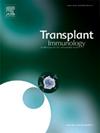抗胸腺细胞球蛋白诱导后较低的嗜碱性粒细胞计数与心脏移植受者较低的急性细胞排斥发生率相关。
IF 1.6
4区 医学
Q4 IMMUNOLOGY
引用次数: 0
摘要
导论:虽然淋巴细胞减少被认为是兔抗胸腺细胞球蛋白(rATG)的一种治疗效果,但伴随的嗜碱性粒细胞计数(BC)的减少尚无临床效果。目的:探讨大鼠g诱导后1年内BC与急性细胞排斥反应(ACR)的关系。方法:回顾性单中心研究纳入2010 - 2021年间183例接受rATG诱导的HTx受体(平均年龄52±13岁,女性23%)。在HTx治疗后的第0、7、14和21天评估绝对淋巴细胞计数(ALC)、血小板计数(PLT)和BC。主要终点是htx后第一年内的首次ACR(分级≥1B)。结果:ACR患者的BC在第14天明显升高(17/μL (IQR 9-43/μL) vs 10/μL (IQR 4-19/μL), p = 0.050), PLT在第7天明显升高(143 × 103/μL (IQR 103-168 × 103/μL) vs 105 × 103/μL (IQR 68-141 × 103/μL), p = 0.02), ALC在第14天升高(308/μL (IQR 171-530/μL) vs 180/μL (IQR 93-317/μL), p = 0.016),第21天升高(529/μL (IQR 240-610/μL) vs 225/μL (IQR 121-328/μL), p。rATG诱导后两周较低的BC与htx后第一年内较低的ACR相关。本文章由计算机程序翻译,如有差异,请以英文原文为准。
Lower basophil count after anti-thymocyte globulin induction is associated with lower incidence of acute cellular rejection in heart transplant recipients
Introduction
While lymphodepletion is considered a therapeutic effect of rabbit anti-thymocyte globulin (rATG), a concomitant decrease in basophil count (BC) has unknown clinical effect.
Objective
To investigate the association between BC following rATG induction and acute cellular rejection (ACR) during the first post-HTx year.
Methods
Retrospective single-center study included 183 HTx recipients receiving rATG induction between 2010 and 2021 (mean age 52 ± 13 years, 23 % female). Absolute lymphocyte count (ALC), platelet (PLT) count and BC were assessed on days 0, 7, 14, and 21 following HTx. The primary outcome was the first ACR (grade ≥1B) within the first post-HTx year.
Results
Patients with ACR had significantly higher BC on day 14 (17/μL (IQR 9–43/μL) vs. 10/μL (IQR 4–19/μL), p = 0.050) and higher PLT on day 7 (143 × 103/μL (IQR 103–168 × 103/μL) vs. 105 × 103/μL (IQR 68–141 × 103/μL), p = 0.02), with higher ALC on day 14 (308/μL (IQR 171–530/μL) vs. 180/μL (IQR 93–317/μL), p = 0.016) and on day 21 (529/μL (IQR 240–610/μL) vs. 225/μL (IQR 121–328/μL), p < 0.001). In univariate analysis, ACR was associated with higher BC on day 14 (p = 0.004), higher PLT on day 7 (p = 0.02), higher ALC on days 14 (p = 0.04) and 21 (p < 0.001). Multivariable regression model showed the most significant association between higher BC on day 14 and ACR (p = 0.015).
Conclusion
Lower BC two weeks after rATG induction is associated with less ACR during the first post-HTx year.
求助全文
通过发布文献求助,成功后即可免费获取论文全文。
去求助
来源期刊

Transplant immunology
医学-免疫学
CiteScore
2.10
自引率
13.30%
发文量
198
审稿时长
48 days
期刊介绍:
Transplant Immunology will publish up-to-date information on all aspects of the broad field it encompasses. The journal will be directed at (basic) scientists, tissue typers, transplant physicians and surgeons, and research and data on all immunological aspects of organ-, tissue- and (haematopoietic) stem cell transplantation are of potential interest to the readers of Transplant Immunology. Original papers, Review articles and Hypotheses will be considered for publication and submitted manuscripts will be rapidly peer-reviewed and published. They will be judged on the basis of scientific merit, originality, timeliness and quality.
 求助内容:
求助内容: 应助结果提醒方式:
应助结果提醒方式:


